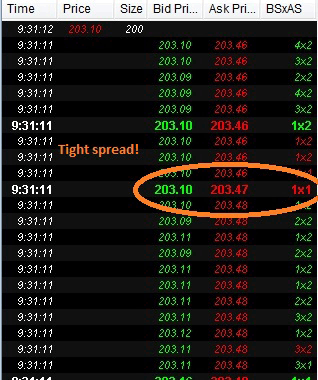Q&A
Since You Asked
with Don Bright

Confused about some aspect of trading? Professional
trader Don Bright of Bright Trading (www.stocktrading.com), an equity trading corporation, answers a few of your questions. To submit a question, post it on the Stocks & Commodities website Message-Boards. Answers will be posted there, and selected questions will appear in future issues of S&C.
FLASH CRASH REDUX?
You have written about the flash crash and its impact on how the markets are working. Has there been anything done to assure that it won’t happen again, or to make the spreads tighter for the average trader? —Maverick99Boston
Talk about a timely issue! My first reaction was to say, “Of course things are much better” — but then I asked Dennis Dick, one of my resident experts, on the topic. He had just put together an article about the subject. Some excerpts:
I bought 500 shares of IBM on the opening print today. You would think 500 shares would be pretty easy to liquidate within a penny or two considering how our market scholars claim that the market has deeper liquidity and tighter spreads than ever before. Anyway, a minute after the open, this is the quote that I was trying to liquidate that 500 shares into (Figure 1).

FIGURE 1: IBM TIGHT SPREAD
Yes, that’s right, you are reading the quote correctly. The spread was 37 cents — 100 shares x 100 shares. Looks pretty thick and deep to me. And why does the quote change so many times in the one-second increment? High-frequency trading (HFT) liquidity providers change their quotes continuously in that increment, usually trying to aggressively penny each other, but then canceling their orders simultaneously.
So if I wanted to sell my 500 shares at the market, I could be filled on 100 shares at 203.10 and pay that 37-cent spread. And on the last 400 shares, who knows where I would be filled?
Well, IBM is a $200 stock, so of course the spread is going to be wider. This isn’t the case with other Dow Jones Industrial Average (DJIA) components, is it? No, they are indeed tighter.
Procter & Gamble (PG) had a nice tight spread of 21 cents, 19 seconds after
the open. Coke (KO) had an 11-cent spread, in the first 30 seconds of trade.
MMM had a cool 25-cent spread after the open.
These are supposed to be some of the most liquid stocks on our exchanges. Where is all this liquidity that
our scholars claim the market has? More online at https://premarketinfo.com/author/premarketinfo/
SUBPENNY SUPPRESSION
I’m constantly frustrated by algorithmic traders stepping in front of my order by a subpenny. I miss a lot of fills because of this. I heard that in Canada they are no longer going to allow trading in subpennies. Is this true? Do you think they will ban subpenny trading in the US as well? —Trader DT
At Bright Trading, we are hoping to see similar action in the near future, but we’re not holding our breath. Once again, I have asked Dennis Dick to elaborate:
“These subpenny trades that you see taking place in front of your limit orders are actually orders executed off-exchange. There are privileged participants, known in the industry as ‘internalizers,’ that will actually buy marketable retail order flow from various brokerage houses in order to trade against it. This is known as payment for order flow. These marketable orders, which are intercepted, would otherwise execute against your publicly displayed order. This is a form of predatory market making and is a profitable business for those firms able to participate. It is a gray practice that has drawn a considerable amount of scrutiny from industry participants over the years, as the practice leaves displayed limit orders unexecuted. In order to justify the practice, the internalizer will often offer some type of subpenny price improvement to the retail market order. It is this subpenny price improvement that you see as subpenny trading on the consolidated tape.
“Our firm has argued to our regulators that the subpenny price improvement given by these internalizers is not enough to warrant taking a fill away from a displayed liquidity provider. We have argued there needs to be some type of meaningful price improvement requirement, greater than the 1/100th of a cent you typically see, put into place. It looks like the Canadian regulator has been reading our SEC comments because they have done just that.
“Effective October 10, 2012, there will be a requirement in Canada that an internalizer must provide a minimum amount of price improvement over the NBBO. This minimum level of price improvement is defined as one trading increment (one cent), or half a trading increment for securities with a bid-ask spread of one cent.
“For stocks with a spread of one cent, you will still see subpenny trades, but at the midpoint, which is much better than price improvement of 1/100th of a cent or nothing at all.
“The bottom line is that displayed orders in Canada will receive a bit more execution priority. This should lead to a lot more executions for limit order traders, which should leave Canadian traders a lot less frustrated. We applaud the Canadian regulator and can only hope the SEC is contemplating a similar move.”
Originally published in the July 2012 issue of Technical Analysis of Stocks & Commodities magazine. All rights reserved. © Copyright 2012, Technical Analysis, Inc.
Return to Contents

